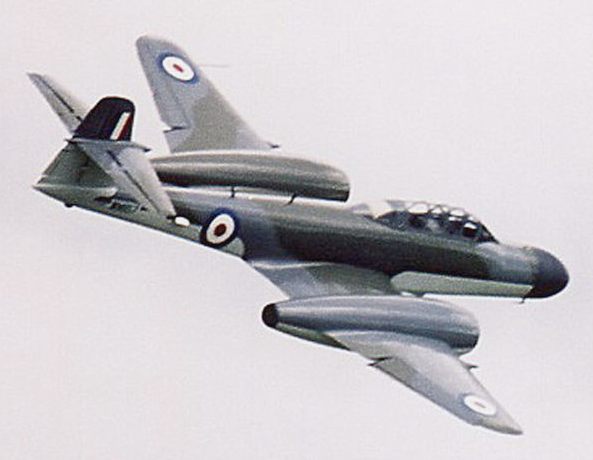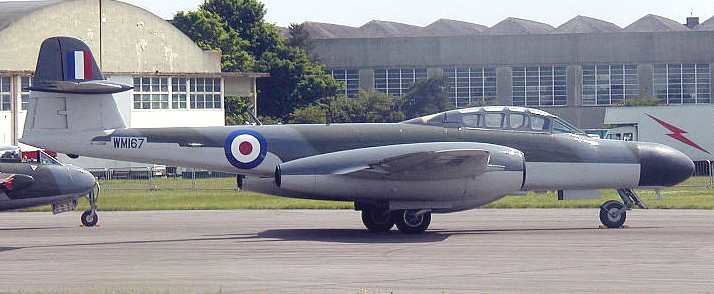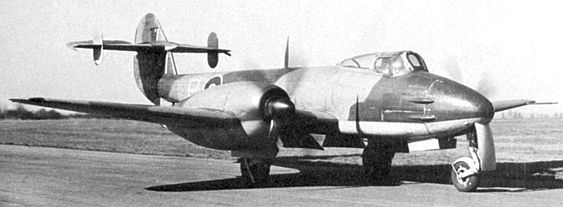|
GLOSTER METEOR
|
||
|
HOME | BIOLOGY | FILMS | GEOGRAPHY | HISTORY | INDEX | MUSIC | SOLAR BOATS | SPORT | SPONSORS |
||
|
The Gloster Meteor was the first operational Allied jet fighter aircraft of World War II. It first flew with the British Royal Air Force (RAF) in 1943, and commenced operations in mid-1944, only some weeks later than the world's first operational jet, the German Messerschmitt Me 262. In early 1946, following the end of the war, a Meteor was used to set a world air speed record of 616 mph (991 km/h) TAS (see below). Meteors remained in service with several air forces for many years and saw action with the Royal Australian Air Force (RAAF) in the Korean War.
Gloster Meteor jet powered aircraft
History
Development began in November 1940 following the invention of the turbojet by Frank Whittle in 1929. Designed by George Carter of the Gloster Aircraft Company, eight prototypes were produced. Originally the aircraft was to have been named Thunderbolt, but confusion with the Republic P-47 led to a name change to Meteor.
The fifth prototype was the first Meteor to fly, when it made its first test flight on March 5, 1943, piloted by Michael Daunt. The prototypes were powered by two de Havilland Halford H.1 turbojets, but de Havilland reserved the production of these engines for its own de Havilland Vampire design.
For the production Meteor Mk. I the engine was switched to the Whittle W.2 design, by then taken over by Rolls-Royce. The current W.2B/23C turbojet engines produced 7.56 kN of thrust each, giving the plane a maximum speed of 417 mph (670 km/h) at 3,000 m, and had a range of 1,610 km. It was 12.5 m long with a span of 13.1 m, had an empty weight of 3,690 kg, and a maximum take-off weight of 6,260 kg. The construction was all-metal with conventional low straight wings, the turbojets were mid-mounted in the wings, and the tailplane was high-mounted to keep it clear of the jet exhaust. It was armed with four 20 mm Hispano cannons. Typical of early jet aircraft, the Meteor suffered from stability problems at high transonic speeds. The aircraft experienced large trim changes, high stick forces, and self-sustained yaw instability (snaking) due to airflow separation over the thick tail surfaces.
The first aircraft were delivered to the Royal Air Force on June 1, 1944 to No. 616 Squadron RAF and one was also sent to the US in exchange for a Bell YP-59A Airacomet for comparative evaluation. No. 616's Meteor Mk. I's saw action for the first time on July 27, 1944 operating against flying bombs, ultimately destroying 14 V-1 flying bombs. The Meteor never saw aerial combat against the Luftwaffe despite flying limited missions over Germany from January 1945, using the Mk. III variant from bases in Belgium.
In early 1946, Gp Capt. Teddy Donaldson set a world air speed record of 616 mph (991 km/h) TAS, in EE549, a Meteor F.4. Test pilot Roland Beamont had previously taken the same aircraft to its compressibility limit at 632 mph, but not under official record conditions, and outside its official safety limits.
RAAF service during the Korean War
The Royal Australian Air Force acquired 113 Meteors between 1946 and 1952.[1] F.8 Meteors saw extensive service during the Korean War with No. 77 Squadron RAAF. The squadron, which had previously flown P-51 Mustangs in Korea, first flew Meteors on July 30, 1951 and had some success in jet-versus-jet combat, against MiG-15 pilots, shooting down five of the newer and generally superior MiGs in the period of September to November.[2] However, four RAAF Meteors were lost on December 1, 1951 in a dogfight between 12 aircraft from 77 Squadron and 40 MiGs. As a result, 77 Squadron was relegated to ground attack duties, a role in which it performed well. While at least 29 Meteors were lost as a direct result of enemy action in Korea, the vast majority of these were shot down by anti-aircraft fire while serving in a ground attack capacity.[3]
Other air forces
Production of the aircraft continued until 1954 and almost 3,900 were made, mainly the Mk. 8. The Meteor was also operated by the airforces of Argentina, Belgium, Brazil, Denmark, Ecuador, Egypt, France, Israel, Netherlands, New Zealand, Syria and Sweden. Late versions, beginning with the F.8 in 1948 were the first British production aircraft to be equipped with ejection seats.
Although many Gloster Meteors survive in Museums and collections only five remain airworthy, four in the United Kingdom and a F8 fighter which was exported to Australia in 2002. The photo shows an Armstrong Whitworth Meteor NF11.
In 1945 a single Meteor I, EE227, (right) was fitted with two Rolls-Royce Trent turboprop engines, making it the world's first turboprop-powered aircraft.
Civilian Gloster Meteor NF.11 (Registered G-LOSM) painted as Royal Air Force Serial WM167 at Kemble, England, 2003
Variants
Specifications (Meteor F Mk 8)General characteristics
Performance
Armament
References
The sole Trent Meteor
LINKS
AVIATION A - Z
A taste for adventure capitalists
Solar Cola - a healthier alternative
|
||
|
This
website
is Copyright © 1999 & 2013 NJK. The bird |
||
|
AUTOMOTIVE | BLUEBIRD | ELECTRIC CARS | ELECTRIC CYCLES | SOLAR CARS |


